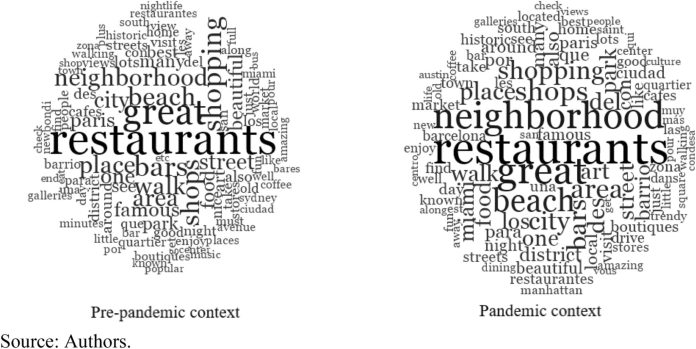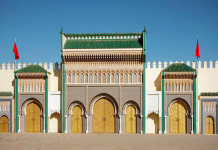International Journal of Tourism Research (2022). DOI: 10.1002/jtr.2551″ width=”800″ height=”401″/>
Airbnb’s Neighborhood Guides. Most reported words. Word Cloud where the size responds to the largest number of citations. Credit: International Journal of Tourism Research (2022). DOI: 10.1002/jtr.2551
“Wander around Trastevere like a Roman”; “This little café in the Latin Quarter in Paris is wonderful”; “Tips to make you feel like a real Berliner.” An increasing number of platforms in the sharing economy such as Airbnb are using slogans like these to create and project the image of tourist destinations in the digital world.
Paradoxically, although their narrative attempts to create a feeling of authenticity, which involves not being a tourist but simply a local resident, a study led by researchers in the New Perspectives in Tourism and Leisure (NOUTUR) group of the UOC’s Faculty of Economics and Business argues that, in fact, they take advantage of the identities of destinations and the communities that live there, and commodify them without taking the needs of the inhabitants of the neighborhoods they advertise into account.
As a consequence, they end up contributing to even higher levels of overcrowding in tourist destinations that are already saturated.
“We’ve seen how Airbnb is today one of the most important players involved in attracting tourists to a city. And it does so primarily through its users and especially its hosts, who become opinion formers and sell you the image of the neighborhood you’re going to be staying in, which is where the platform’s business lies,” said Lluis Garay, a researcher in NOUTUR, member of the Faculty of Economics and Business at the UOC, and co-author of this study, which appears in the International Journal of Tourism Research.
Big data analysis of Airbnb
The NOUTUR group has spent years studying the impact that these online tourism platforms, and Airbnb in particular, have on the cities they advertise. In this new study, they specifically examine how the platform creates tourist images of destinations. To do so, they applied a methodology that they had developed in previous studies, and analyzed a huge volume of data from more than 24,000 descriptions that users of Airbnb made of 500 urban neighborhoods in cities in the northern hemisphere, between 2008 and the onset of the COVID-19 pandemic.
Specifically, they examined the cognitive and affective attributes of the descriptions of the destinations, and classified them by category. They found that the images of cities projected in the Airbnb guides—a series of pages showing the best-known neighborhoods in major tourist destinations which are often based on comments posted by guests and hosts—are the main devices used to suggest authenticity, aimed at convincing tourists to visit a city and experience it as if they were residents themselves.
“Airbnb has been particularly astute in using host-created guides to construct its own narrative about global urban neighborhoods and to create affective attributes for places,” pointed out Soledad Morales, the academic director of the Master’s Degree in Sustainable Tourism and ICT and a member of NOUTUR.
“Using the recommendations label, the company simulates an environment of trust in which the owners talk to potential tourists, without any apparent involvement by the company. But these platforms turn the hosts into ‘ambassadors’ and opinion formers for their brand and philosophy, and the creators of an emotional bond with the destinations, which is the key factor in tourists visiting the destination again in the future,” added the researcher.
Interestingly, Airbnb doesn’t work with neighborhood guides for all destinations, but only for those that are in the world’s most visited cities, which are already saturated by tourism. “It’s a colonialist perspective, which primarily projects the neighborhoods of cities that are among the 20 most visited in the world and are geographically located in the Global North, and fails to include Africa, for example,” Morales said.
Stereotypical images of destinations
Another of the main results of this study is that many of these images of destinations projected reproduce stereotyped forms of tourism, leading to the homogenization of cities, which usually have the same shops and establishments in the center.
Another result that surprised the researchers is that Airbnb didn’t include any direct references to safety in its guides or in its descriptions. On the contrary, and during the pandemic in particular, the platform’s strategy was to emphasize the neighborhoods’ reputations and remind users of the wide range of opportunities for consumption available to them.
Rather than being a criticism, the authors of this study said that the results of the research should make the users, i.e. the hosts, but also the platforms themselves consider the role they can play as factors in tourists’ awareness. “The platforms could contribute to raising travelers’ awareness of the impacts they have on their destination,” Garay pointed out.
Location, location, location: Study reveals effects of Airbnb
More information:
Lluís Alfons Garay‐Tamajón et al, ‘Belong anywhere’: Focusing on authenticity and the role of Airbnb in the projected destination image, International Journal of Tourism Research (2022). DOI: 10.1002/jtr.2551
Provided by
Universitat Oberta de Catalunya
Citation:
How does Airbnb contribute to projecting the image of tourist destinations? (2022, October 5)
retrieved 6 October 2022
from https://phys.org/news/2022-10-airbnb-contribute-image-tourist-destinations.html
This document is subject to copyright. Apart from any fair dealing for the purpose of private study or research, no
part may be reproduced without the written permission. The content is provided for information purposes only.













